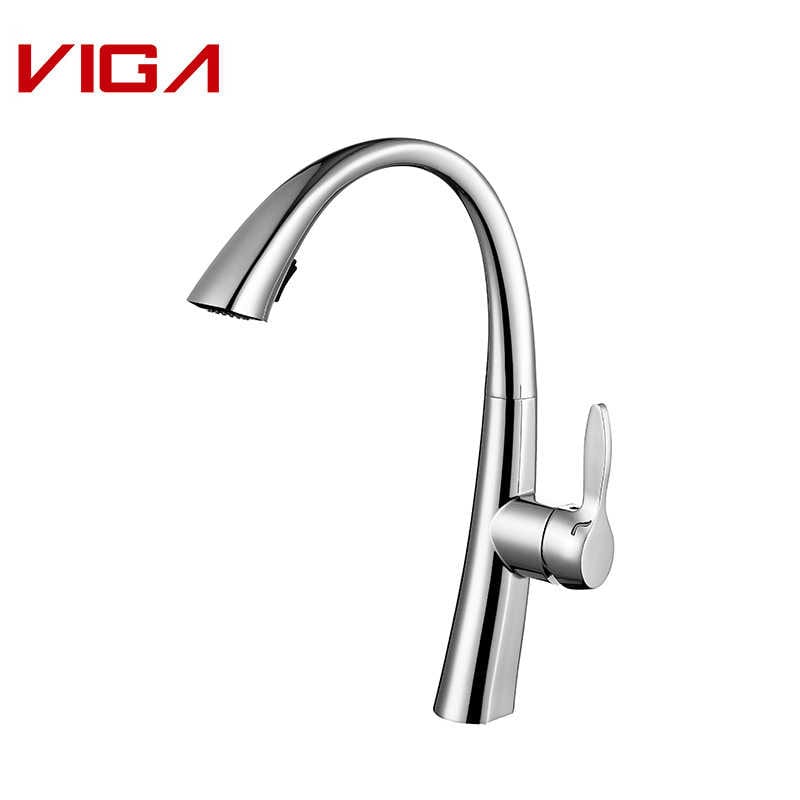Kitchen faucets date back to the ancient times and therefore have a long history of keeping water conveniently accessible for many homes.
The kitchen faucet is probably the most used feature in any kitchen. An average family is estimated to press the tap more than 40 times a day. That’s according to a report by KWC company. So it only makes sense that one should think of the kitchen faucet more thoughtfully, including how to choose the right one for your kitchen style, lifestyle and how to make it last through the years.
A typical faucet may last a decade or longer. The first to give out would be the finish while plastic and zinc give out in just five years. Make sure you make your kitchen faucet last longer by preserving the finish and by not using abrasives or ammonia.

The Ancient Romans in the 1000 BC used silver faucets. లో 1700 క్రీ.పూ, the Minoan Place of Knossos, held a terra cotta piping that pumped water into fountains. In the Middle Ages, kitchens were the central part of the home and almost everything revolved around it. లో 1845, the first screw down tap mechanism was made by Gust and Chimes.
లో 1937, a man named Alfred Moen invented a single-handed faucet that blended cold and hot water before it exited the “fixture.” He came up with the idea after burning his hands with a two handle convectional faucet, one for cold and one for hot. He thought that there should be a way to get what you wanted out of a faucet. అతను ఒకే సమయంలో ఉష్ణోగ్రత మరియు నీటి ద్రవ్యరాశిని ఒకే హ్యాండిల్ కుళాయిలోకి నియంత్రించే సిద్ధాంతంతో ముందుకు వచ్చాడు. అతను నుండి కుళాయి రూపకల్పన కొనసాగించాడు 1940 కు 1945 ఆపై తన మొదటి సింగిల్ హ్యాండ్ పీపాను అమ్మాడు 1947. ద్వారా 1959, ఒకే చేతి కొళాయిలు దాదాపు ప్రతి ఇంటిలో ఉన్నాయి.
లో 1945, లాండిస్ హెచ్. పెర్రీ, ఒక సాధారణ ముద్ర కోసం వాల్యూమ్ మరియు బ్లెండింగ్ను కలిపిన మొదటి బాల్ వాల్వ్ను సృష్టించింది. ఇది కుళాయిని మరింత ప్రభావవంతంగా చేసింది. పెర్రీ తన పేటెంట్ను అలెక్స్ మనోగియన్కు విక్రయించాడు, క్రమంగా, డెల్టా కుళాయిని కనిపెట్టాడు 1954. ఈ కుళాయి ఆలోచనలు మరియు కొళాయి హిట్ అయ్యింది. లో 1958, డెల్టా కుళాయి విక్రయాలు చేరుకున్నాయి $1 మిలియన్.
1970లలో, సిరామిక్తో తయారు చేయబడిన డిస్క్ను వోల్వరింగ్ బ్రాస్ కనుగొన్నారు, ఇది నీటి ప్రవాహాన్ని నియంత్రించడంలో సహాయపడింది. అప్పటి నుండి, ప్రతిఘటన మరియు సామర్థ్యాన్ని పెంచడానికి డిస్క్ కొన్ని సార్లు మార్చబడింది.
ఈరోజు, we have the ability to pull out sprays and electronic faucets that were made by a various group of inventors. The fact that the kitchen faucet came this far in such a short time only shows it will continue to develop in the future.
Facts
- According to Gale Research, “A faucet is a device for delivering water from a plumbing system. It can consist of the following components:spout, handle(s), lift rod, cartridge, aerator, mixing chamber, and water inlets. When the handle is turned on, the valve opens and controls the water flow adjustment under any water or temperature condition. The faucet body is usually made of brass, though die-cast zinc and chrome-plated plastic are also used.” and “faucets come in a wide range of styles, colors, and finishes. Ergonomic designs may involve a longer spout length and easier to operate handles. The shape of the faucet and its finish will affect the manufacturing process. Some designs will be more difficult to machine or forge than others. A different finishing process may be used to achieve a different look.”
- Faucets are made to turn on and off the water, control the water temperature and provide a fast and efficient means to obtain water in the kitchen.
- Faucets are made to save time and energy. The lower the water flow rate, the more energy the faucet can save.
- According to Will Ford and Kitchen Faucet Center, “In a household full of 4 ప్రజలు, faucet water is about 18% of the water consumption which is a lot to say the least. Over the course of a year, the average household uses between 6,600-9,750 సంవత్సరానికి గాలన్ల నీరు."
- వాటర్సెన్స్ ప్రకారం, సెకనుకు ఒక బిందువు చొప్పున కారుతున్న కారుతున్న పీపాలో నుంచి నీళ్లు బయిటికి రావడమునకు వేసివుండే చిన్న గొట్టము దాని కంటే ఎక్కువ వృధా చేస్తుంది 3,000 సంవత్సరానికి గాలన్లు. వాటర్సెన్స్ లేబుల్ చేయబడిన మరుగుదొడ్లు ఉన్న ఇల్లు ఆరు నెలల పాటు ఫ్లష్ చేయడానికి ఆ నీటిని ఉపయోగించవచ్చు!
- ఒక సగటు అమెరికన్ కుటుంబం సగటును ఉపయోగిస్తుంది 140 రోజుకు గ్యాలన్ల నీరు.
- ప్లంబింగ్ సరఫరా ప్రకారం, "ఫ్లో-ఫ్లో ఏరేటర్లు ఫ్లో రేట్ను ఫెడరల్ స్టాండర్డ్లో/తక్కువగా ఉంచుతాయి 2.2 gpm, మీ ఇంటి కుళాయిలు చాలా తక్కువ నీటిని ఉపయోగిస్తాయి. కానీ వారి భారీ ఉపయోగం ఇచ్చిన, వారు ఇప్పటికీ వరకు లెక్కించవచ్చు 20% ఇంటి రోజువారీ ఇండోర్ నీటి వినియోగం. సాధారణ గృహస్థులు తమ కుళాయిల నుండి రోజుకు 18–27 గ్యాలన్ల వరకు డ్రా చేస్తారు, చేతులు కడుక్కోవడం నుండి వంట చేయడం వరకు అన్ని కుళాయి వినియోగాన్ని కలిగి ఉంటుంది. Bear in mind that faucets without aerators — usually kitchen or laundry faucets — can have flow rates beyond 3 gpm, which wastes a lot of water.”
Statistics
- According to a 2014 Government Accountability Report,“40 out of 50 state water managers expect water shortages under average conditions in some portion of their states over the next decade.”
- According toUSA EPA, “Turning off the tap while brushing your teeth can save 8 gallons of water per day and, while shaving, can save 10 gallons of water per shave. Assuming you brush your teeth twice daily and shave 5 times per week, you could save nearly 5,700 సంవత్సరానికి గాలన్లు. Letting your faucet run for five minutes while washing dishes can waste 10 gallons of water and uses enough energy to power a 60-watt light bulb for 18 hours.”
ధరలు
The prices on faucets vary. They can be determined through material, డిజైన్, function, and mobility. It’s up to the consumer to decide which type would be the best fit for their home. Installation also comes into consideration when determining the price. Here is a brief example of how prices can vary:
“Many water providers give low-flow aerators out to their customers for free or you can purchase one at many home improvement stores for about $1-5.00 each.”
 iVIGA ట్యాప్ ఫ్యాక్టరీ సరఫరాదారు
iVIGA ట్యాప్ ఫ్యాక్టరీ సరఫరాదారు
